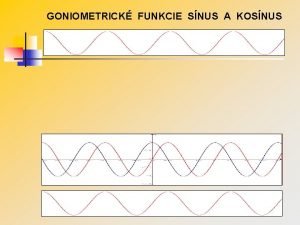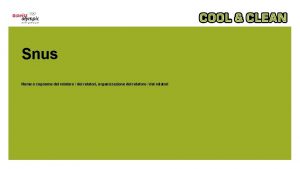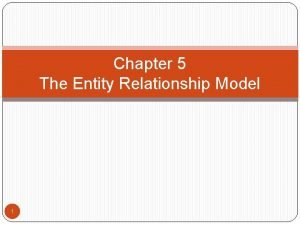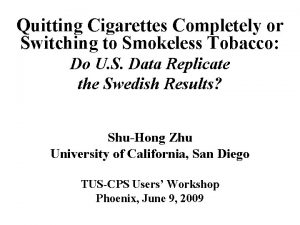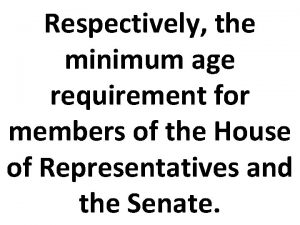Quitting cigarettes respectively snus motivation versus dependence Lars















- Slides: 15

Quitting cigarettes respectively snus – motivation versus dependence Lars M. Ramström Institute for Tobacco Studies Täby, Sweden lars. ramstrom@tobaccostudies. com No conflict of interest UKNSCC 2016 Thursday 9 th June - Friday 10 th June 2016

Smoking prevalence in the EU 2014 38% 35% 26% 19% 20% 21% FI MT SK 21% 21% 22% IT LU IE UK 11% SE Source: Eurobarometer 429 (2015) EU 28 BG EL

18% Current or former regular use of snus or other oral tobacco in the EU 2014 2% SE FI 1% 1% 1% EE CZ DK AT LU Source: Eurobarometer 429 (2015) 0% ALL OTHER

Prevalence is determined by two factors: initiation and cessation. The current study looks into cessation matters.

Quit ratios for smoking in the EU 2014 74% Proportion of Ever smokers who have quit smoking 57% SE DK 57% NL 56% FI Source: Eurobarometer 429 (2015) 51% LU 49% MT 48% EE 46% UK 43% EU 28 33% 32% CY RO

Quit ratios for snus use in the EU are not available. In Sweden a nationwide representative study has provided quit ratios both for snus use and for smoking in the same period.

Quit ratios in Sweden For smoking For snus use Men n=11557 Women n=12798 Men n=8758 Women n=1488 70% 62% 35% 38% Source: YCYL study 2003 -2011 Quit ratios are much lower for snus use than for smoking

Quit ratios are influenced by the strength of dependence that hampers quitting, and the strength of motivation to quit. The nationwide representative FSI/ITS surveys 2003 -2006 (n=33641) examined how these parameters are associated with quitting of smoking respectively snus use.

Questionnaire item to measure dependence How soon after wakening up do/did you take your first cigarette/snus? After >60 minutes (0 points) Within 31 -60 minutes (1 point) Within 6 -30 minutes (2 points) Within 5 minutes (3 points)

Questionnaire item to measure motivation to quit smoking/snus use Do/did you have a desire to quit? None (0 points) Some (1 point) Strong (2 points)

Mean dependence scores Exclusive smokers Exclusive snus users Men n=1607 1. 66 Women n=2764 Men n=1628 Women n=176 1. 57 1. 52 95% CI 1. 61 -1. 71 95% CI 1. 53 -1. 61 1. 67 95% CI 1. 63 -1. 71 95% CI 1. 37 -1. 67 Source: FSI/ITS surveys 2003 -2006 Dependence levels do not differ between exclusive smokers and exclusive snus users. Dependence levels tend to be slighgtly higher in men than women, but the difference is not significant for snus users.

Mean motivation scores Exclusive smokers Exclusive snus users Men n=1536 1. 21 Women n=2646 Men n=1566 Women n=169 1. 25 0. 93 95% CI 1. 18 -1. 24 95% CI 1. 23 -1. 27 0. 70 95% CI 0. 67 -0. 73 95% CI 0. 83 -1. 03 Source: FSI/ITS surveys 2003 -2006 Motivation levels differ significantly between exclusive smokers and exclusive snus users. Motivation levels tend to be slighgtly higher in women than men, but the differences are not significant.

Among men about a third of originally exclusive smokers have also taken up snus use. Most of them (almost 90%) have thereby quit smoking, but some are Dual users, using both cigarettes and snus.

Dual users’ mean scores (men) Dependence on … Motivation to quit. . …smoking n=196 1. 70 …snus use n=193 …smoking n=192 …snus use n=191 1. 02 0. 78 95% CI 1. 57 -1. 83 95% CI 0. 89 -1. 15 1. 26 95% CI 1. 17 -1. 35 95% CI 0. 68 -0. 88 Source: FSI/ITS surveys 2003 -2006. Statistics for women not reported because of insufficiently small numbers (n<50). Dual users have similar dependence on smoking as exclusive smokers. Dual users have slightly but not significantly higher motivation to quit smoking than exclusive smokers. Dual users’ dependence is significantly lower for snus use than for smoking. Dual users’ motivation to quit is significantly higher for smoking than for snus use.

Conclusions The lower quit ratios for snus use than for smoking appear not to be due to higher dependence in snus users but to lower perception of motives to quit. Smokers’ uptake of snus use appears not to weaken desire to quit smoking or worsen dependence on smoking.
 On quitting by edgar albert guest
On quitting by edgar albert guest Brett burks primerica
Brett burks primerica Inspire vs motivate
Inspire vs motivate Snus blodtryckshöjande
Snus blodtryckshöjande Strsta
Strsta Kosnus
Kosnus Snus effetti positivi
Snus effetti positivi Snus dohánybolt
Snus dohánybolt Snus droga
Snus droga Snus leistungssteigerung
Snus leistungssteigerung What is meant by structure dependence
What is meant by structure dependence Galbraith dependence effect
Galbraith dependence effect The function that an entity plays in a relationship
The function that an entity plays in a relationship A dbms reduces data redundancy and inconsistency by
A dbms reduces data redundancy and inconsistency by Psychological dependence
Psychological dependence Linear independence of vectors
Linear independence of vectors





